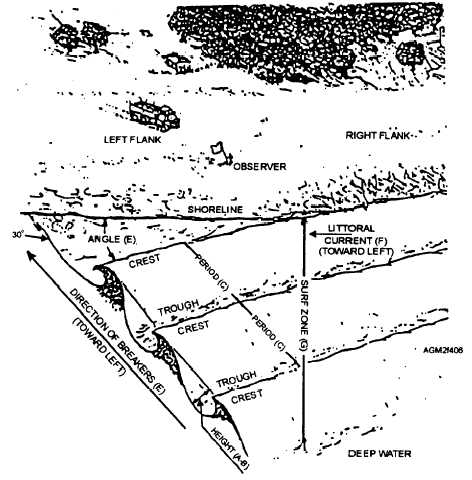Surging breakers are normally seen only with a very
steep beach slope. This type of breaker is often
described as creating the appearance that the water level
at the beach is suddenly rising and falling. The entire
face of the wave usually displays churning water and
produces foam, but an actual curl never develops. The
water depth decreases so rapidly that the waves do not
reach critical steepness until they are right on the beach.
The entire wave surges up the beach and most of the
energy is reflected back seaward. These wave can be
very dangerous for landing craft. After the wave pushes
the craft up the beach, the entire wave returns as a wall
of water striking the craft.
Your determination of breaker height and breaker
type is a very important part of the SUROB. The
breaker type should be entered along with each entry of
breaker height on the SUROB worksheet. Breaker type
is to be evaluated for the same 100 breakers evaluated
for height. All the breakers in the significant breaker
area need not be the same type of breaker. You may, for
instance, see three plunging breakers followed by four
spilling breakers. The SUROB report requires that the
percentage of each type of breaker observed be entered
as element DELTA.
Breaker Angle (ECHO)
Because wave speed decreases as the waves enter
shallower water, waves approaching the beach at an
angle are refracted and approach the beach more
parallel. Although waves are refracted, many situations
produce breakers that approach the beach at an angle.
Breaker angle is the angle the breaker makes with the
beach, and is a critical factor in the creation of a littoral
current. The greater the breaker angle, the stronger the
littoral current.
Breaker angle must also be identified by the
direction toward which the breakers are moving. Beach
directions are identified by the direction as seen from an
approaching landing craft. Looking from the sea toward
shore, the left flank is toward a landing craft’s left side
(port side) and the right flank is toward the landing
craft’s right side (starboard side). See figure 4-6.
Breaker angle is entered as element ECHO of the
Figure 4-6.—Wave angle and beach directions. The wave angle in this case is about 30 degrees left flank.
4-7


